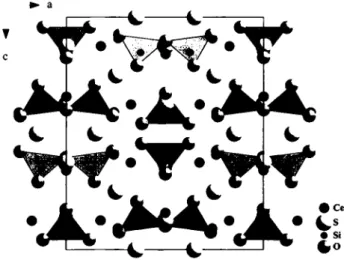Ζ. Kristallogr. N C S 2 1 7 ( 2 0 0 2 ) 1 7 5 - 1 7 6 175
© by Oldenbourg Wissenschaftsverlag, München
Crystal structure of tetracerium(III) trisulfide heptaoxodisilicate(IV), Ce
4S
3[Si
207]
I. Hattenbach and Th. Schleid*
Universität Stuttgart, Institut für Anorganische Chemie, Pfaffenwaldring 55, D-70569 Stuttgart, Germany
Received February 26, 2002, accepted and available on-line May 7, 2002; CSD-No. 409606
Ce
c w " c i
•JÍ¿M<'JL· ν
* L * ^ ^ * I » fc
Abstract
Ce407S3SÍ2, tetragonal, ΙΛι/amd (No. 141), a = 12.0543(8) Â, c = 14.2351(9) Â, V = 2068.4 À3, Ζ = 8, tfgtfF) = 0.027,
wRretfF1) = 0.060, T= 298 K.
Source of material
Colourless transparent single crystals of Ce4Sj[SÍ2C>7] were obtained as almost regular octahedra by the reaction of cerium dioxide and cerium with sulfur and silicon dioxide (molar ratio 3:1:6:4) in an excess of molten cerium trichloride as fluxing agent at 1123 Κ for seven days in an evacuated silica ampoule. The crystals of the title compound emerged as main product (along with traces of CeOCl and Ce2C>2S as by-products) and remain stable to air and water.
Discussion
Although compounds of the general formula M4S3[SÍ2<>7] (M = La - Nd, Sm, Gd - Yb) are already known [1-8], it was not possi- ble to synthesize the single-crystalline isotypic cerium compound up to now [9].
TTie title compound contains isolated pyroanionic [SÍ207]6- units surrounded by twelve cerium atoms as terminal and edge- spanning ligands. The (Cel)3+ cations are even able to connect
the bridging oxygen (03) although this Ce—O distance is rather long (326 pm). Both crystallographic independent Ce3+ cations show tricapped trigonal prisms (CN = 9) as coordination polyhe- dra built of four oxygen and five sulfur atoms in case of Cel but seven O2 - and two S2" for Ce2. The Ce3+—O2" distances with values of 241 pm - 267 pm (except the very long distance of 326 pm mentioned before) range in the region expected for those sep- arations just like the Ce3*—S2"bond lengths (¿(Ce—S) = 290 pm - 344 pm). All oxygen atoms belong to vertex-shared double tet- rahedra of disilicate anions [S12O7] showing Si—O distances of 161 pm - 164 pm and O-Si-O angles of 104° - 120° very much like almost every other compound containing single or ver- tex-connected [S1O4]4" tetrahedra. The bridging angle (Si-O-Si) of the disilicate unit lies with 132° close to those of the A- and G-type rare-earth disilicates(M2[SÍ2C>7]) [10]. Finally, the crystal structure distinguishes three S2~ anions that once exhibit an envi- ronment of six Ce3+ cations in the shape of a rather distorted octahedron (SI), and twice one of four cerium atoms either form- ing a seesaw (S2) or a flat square (S3), respectively. The whole structure consists of layers of disilicate anions parallel (001) con- taining both types of cerium cations as well as the (S2) ~ and the (S3)2' anions. These are separated by the high-coordinated sul- fide atoms in position S1. The stacking order can be considered as Α, -Β, B, -A where A and Β are the same layers but perpendicular rotated against each other around the c-axis, as can be seen in the figure.
Table 1. Data collection and handling.
Crystal: colourless octahedron,
size 0.08 χ 0.08 χ 0.08 mm Wavelength: Mo Ka radiation (0.71069 À)
181.17 cm"1
Diffractometer, scan mode: Nonius Kappa-CCD, φ/ω
20max: 55.3°
Af(AW)measured, WlW)unique: 9174,669 Criterion for loba, N(hkl)$:. /obs > 2 a(iobs), 616 N(paramjKf[aa¡·. 47
Program: SHELXL-97 [11]
* Correspondence author (e-mail: schleid@iac.uni-stuttgait.de)
176 Ce4S3[Si207]
Table 2. Atomic coordinates and displacement parameters (in Â2).
Atom Site X y ζ Un t/22 t/33 U ,2 Un Un
Ce(l) 16A 0 0.01366(4) 0.34060(4) 0.0154(3) 0.0176(3) 0.0155(3) 0 0 -0.0014(2)
Ce(2) 16« 0.17510(3) jc+1/4 7/8 0.0100(2) Un 0.0112(3) 0.0011(2) -0.0001(1) -l/|3
S(l) 16/ 0.3512(2) 0 0 0.0066(9) 0.027(1) 0.010(1) 0 0 0.0072(9)
S(2) 4b 0 1/4 3/8 0.009(1) Un 0.016(2) 0 0 0
S(3) 4a 0 3/4 1/8 0.005(1) Un 0.013(2) 0 0 0
Si 16A 0 0.3728(2) 0.0959(2) 0.0030(9) 0.0048(9) 0.008(1) 0 0 -0.0004(8)
0(1) 32i 0.1154(3) 0.1133(3) 0.0402(3) 0.010(2) 0.011(2) 0.012(2) -0.001(2) 0.003(2) -0.001(2)
0(2) 16A 0 0.0250(4) 0.1715(4) 0.010(3) 0.005(2) 0.009(3) 0 0 0.004(2)
CK3) 8« 0 1/4 0.6074(5) 0.010(4) 0.019(4) 0.005(4) 0 0 0
Acknowledgments. The authors gratefully acknowledge the support of the Deutsche Forschungsgemeinschaft (Bonn, Germany), the Fonds der Chemischen Industrie (Frankfurt/Main, Germany) and the State of Baden-Wüittemberg (Stuttgart, Germany).
References
1. Siegrist, T.; Petter, W.; Hulliger F.: Samarium Pyrosilicate Sulfide, Sm4S3[Si207]. Acta Ciystallogr. B38 (1982) 2872-2874.
2. Gmpe, M.; Lissner, F.; Schleid, Th.; Urland, W.: Chalkogenid-Disilicate der Lanthanoide von Typ MjSíÍSííO?] (M=Ce - Er, Χ = S, Se). Ζ. Anorg.
Allg. Chem. 616 (1992) 53-60.
3. Range, K.-J.; Andratschke, M.; Gietl, Α.: Cry sal structure of ytter- bium(m) trisulfide disilicate Yb4S3[S¡2(>7]. Ζ. Kristallogr. NCS 211 (1996) 816.
4. Sieke, C.: Der Einfluss von Sulfid- und Chloridanionen auf die Kristallchemie von Silicaten, Boraten und Phosphaten dreiwertiger Tanthanide. Dissertation, University of Stuttgart, Germany 1998.
5. Sieke, C.; Schleid, Th.: Sm4S3[SÍ2(>7] und N a S n ^ Ì S i O ^ e : Zwei Sulfidsilicate mit dreiwertigem Samarium. Ζ. Anorg. Allg. Chem. 625 (1999) 131-136.
6. Zeng, H.-J.; Mao, J.-G.; Huang, J.-Sh.: Synthesis and crystal structure of La4S3[Si207]. J. Alloys Compds. 291 (1999) 89-93.
7. Sieke, C.; Schleid, Th.: Pt4Sj[SÍ2C>7] und Pr3Cb[SÍ207]: Durch weiche Fremdanionen modifizierte Derivate von Praseodymdisilicat. Z. Anorg.
Allg. Chem. 626 (2000) 196-201.
8. Hattenbach, L; Sieke, C.; Schleid, Th.: M4S3ÍSÍ207] (M = Gd - Yb):
Sulfid-Oxodisilicate der schweren Lanthanoide. Z. Naturforsch. 57b (2002), to be submitted.
9. Hattenbach, I.: Anionenderivatisierte Oxo- und kationenderivatisierte Thiosilicate der Selten-Erd-Elemente. Dissertation, University of Stuttgart, Germany 2001, Mensch & Buch Verlag Berlin, ISBN 3-89820-294-1.
10. Felsche, J.: Hie Crystal Chemistry of Rare-Earth Silicates. In: Structure and Bonding 13, p. 99-197, Springer-Verlag (Berlin, Heidelberg, New York) 1973.
11. Sheldrick, G. M.: SHELXL-97. Program for refining crystal structures.
University of Göttingen, Germany 1997.

